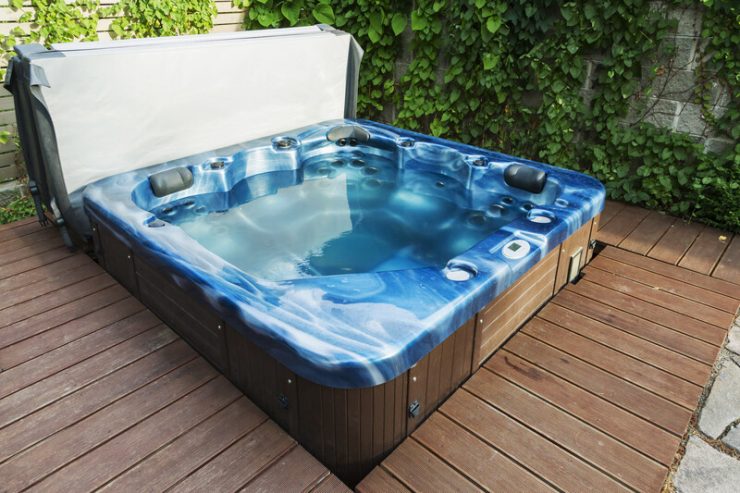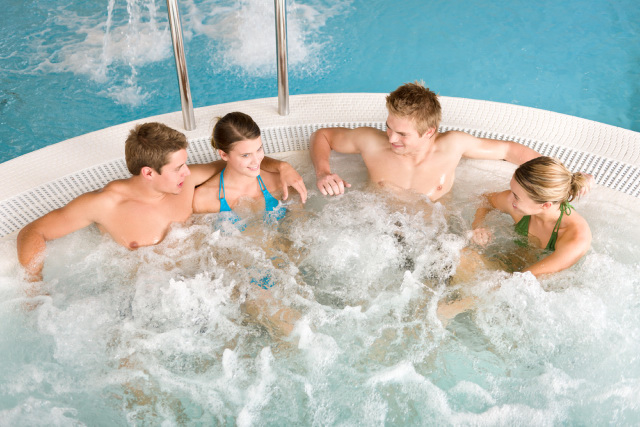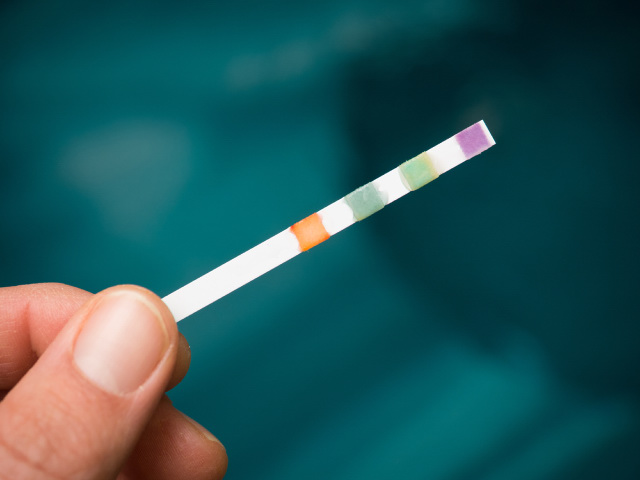Relaxing in your hot tub after a stressful day is the dream of so many people. But maybe you notice your skin feels dry after a soothing soak. Your hot tub’s low alkalinity level could be the culprit.
So, how do you raise the alkalinity level back into normal ranges?
The best way to raise the alkalinity in a hot tub is to add baking soda or soda ash. First, however, it’s crucial to test the water to check all water chemistry levels before adding either raising agent. Then retest the hot tub alkalinity for at least 6 hours before retesting.
Before diving into the step-by-step guide, let’s look at why a normal alkalinity level is critical for your hot tub.

Article Contents
What is Total Alkalinity?
Essentially, total alkalinity measures the water’s ability to buffer pH fluctuations.
Total alkalinity measures dissolved alkali substances in the water. These substances (bicarbonate, hydroxide, carbonate) help regulate the water’s pH level. This regulation is essential when adding pool chemicals to the water.
After adding to your tub, some chemicals can affect the pH level. For example, without a healthy total alkalinity level, the water pH will wildly fluctuate. Total alkalinity will react to the pH-affecting chemical and neutralize it. And, therefore, maintain the pH level.
However, total alkalinity doesn’t determine what the pH level will be. Instead, it helps keep it within the desired pH range (7.2-7.8).
What is Considered Low Total Alkalinity?
Low total alkalinity is any measurement below 80 ppm. It can be hard to notice at first. But, with low alkalinity, the hot tub’s pH level will drop (become more acidic).
With this acidic water, surfaces and metallic elements are at risk of damage. For example, you might notice wear on the hot tub walls. Or some rust is appearing on the metal piping feeding into the tub.
You may feel the effects of low alkalinity on your skin as the acidic water comes into your more pH-basic skin. Your skin, eyes, or throat could become irritated with contact.
What Should Alkalinity Be?
Your hot tub’s total alkalinity level should be between 80 to 120 ppm. Outside of this range, there will be knock-on effects on water chemistry and the hot tub’s integrity.
As discussed, below 80 ppm, the water will become more acidic. Therefore, it will reduce the effect of other water chemicals and permanently damage your hot tub’s walls and piping.
Above 120 ppm, the ability of alkalinity to offset pH creates acidic water too. With high alkalinity, you can expect effects such as cloudy water and clogged filters. If you’re curious about how to combat high alkalinity, check out our guide here: How to Lower Alkalinity | Pool Alkalinity High
How Do You Know if Alkalinity is Low?
When the total alkalinity level drops below its optimal range (80-120 ppm), the signs can be subtle at first. For example, your regular sanitizer might not be working as well. And you might notice elements of your hot tub are starting to wear away.
For example, along with irritated skin/eyes, you may notice that you need to add more sanitizer to maintain your hot tub.
Chlorine, in particular, will be less effective, so you’ll have to add more to achieve the same effect. And, because chlorine has a high pH, the low alkalinity level won’t be able to buffer it as well. So, you’ll have to add more acid to lower the pH.
Is it Bad to Have Low Alkalinity in Hot Tub (What Will Happen)?
Having a low alkalinity level can wreak havoc on your hot tub. Because low alkalinity allows for more acidic water, every hot tub element is vulnerable to corrosion or wear and tear.
With low alkalinity comes high pH, so metallic elements, in particular, are at risk of corrosion. And this includes internal metallic components such as pipes, heaters, and pump seals.
Not just metallic surfaces are susceptible; surfaces such as the hot tub walls are vulnerable too. Acidic water can etch into the walls and cause cracks and delamination. And this includes typical hot tub materials such as fiberglass and vinyl.
Aside from structural damage, low alkalinity will decrease the effectiveness of your hot tub sanitizer, particularly chlorine. Therefore, you’ll need to add more chlorine and pool chemicals to rebalance the water chemistry.
Is it Safe to Swim in a Hot Tub with Low Alkalinity?

With all the corrosive risks that come with low alkalinity, it’s only natural to ask if it’s safe to swim in your hot tub during this time.
It’s not advisable to swim in a hot tub with low alkalinity. The knock-on effects of low alkalinity and increased pH include skin and respiratory irritation.
Restrict its use once you realize your hot tub’s low alkalinity level. The hot tub’s water is more acidic, with increased chlorine application. This acidic water will interact with the pH of your skin, eyes, and respiratory tracts.
Unfortunately, this irritation indicates that the alkalinity level is off, but there won’t be any lasting damage once discovered.
Aside from acidic water, the ineffectiveness of chlorine allows for algae blooms and bacteria to grow unchecked. These can lead to infection and stomach illnesses.
Chemicals to Raise Hot Tub Alkalinity
The most common chemicals used to raise total alkalinity are baking soda and soda ash. The difference between these two chemicals is that soda ash will increase pH, whereas baking soda will have minimal impact on pH.
Baking soda (sodium bicarbonate) is an ideal chemical as it’s entirely safe for use. And you can get it at most grocery stores from the baking section. So, if the hot tub’s pH is reading normal, choosing baking soda is your best option.
Even though they seem similar, you need to handle soda ash (sodium carbonate) with care. Protective equipment and good ventilation are essential when using this product. But, it is the perfect pick if you need to raise your pH significantly along with alkalinity.
So, how do you know how much baking soda or soda ash to use for your hot tub?
How Much Baking Soda to Raise Alkalinity of Hot Tub?
The general rule of thumb is to use one tablespoon (tbsp) of baking soda for every 100 gallons (379 L) of water.
So, if your hot tub is 400 gallons (1,514 L), add 4 tbsp of baking soda to raise the total alkalinity.
This table shows roughly how much baking soda you will need to add per 500 gallons (1,893 L) of hot tub water.
| Total Alkalinity Increase | Baking Soda Amount |
| 10 ppm | 1.2 oz |
| 20 ppm | 2.4 oz |
| 30 ppm | 3.6 oz |
| 40 ppm | 4.8 oz |
| 50 ppm | 6 oz |
How Much Soda Ash to Raise Alkalinity of Hot Tub?
Just as with baking soda, the rule of thumb is to use one tablespoon (tbsp) for every 100 gallons (379 L) of water.
About 1.2 ounces of sodium carbonate (soda ash) per 500 gallons (1,893 L) will raise the alkalinity by 10 ppm and it will also substantially raise the pH. Unlike baking soda. The exact amount the pH and alkalinity increase will however depend on the chemistry of the water and the water temperature.
As we always say, it’s better to use less than what you think you’ll need.
Related Reading: What Order Should You Add Chemicals in a New Hot Tub? A Hot Tub Start-Up Guide
How to Raise Alkalinity in Hot Tubs (Step By Step)?
Whether you choose to use baking soda or soda ash, there isn’t much of a difference when applying it to your hot tub. The only difference is to ensure you wear protective gear when handling soda ash.
Even though you can get baking soda at most grocery stores, keeping your pool baking soda separate from your baking soda will help prevent cross-contamination.
To apply your chosen raising agent:
1. Test the Water
Firstly, test your hot tub with pool chemistry test strips to get a baseline of your chemicals. Then calculate how much you need to raise total alkalinity to at least 80 ppm.
Check the hot tub manual to find its water capacity.
2. Measure Baking Soda
Wear gloves and goggles. Although baking soda isn’t harmful, it can irritate your eyes. So, getting into this habit with either chemical is ideal.
You’ll need about 1.2 oz per 500 gallons (1,893 L) of hot tub water to raise it to 10 ppm.
3. Add to Hot Tub
Thoroughly dissolve the calculated baking soda/soda ash dosage in a bucket of water. Add to your hot tub and allow the water to circulate for at least 6 hours.
Start by using about half of what you think you’ll need.
4. Retest the Water
Use another test strip to get a new reading. Repeat the steps until you reach the desired 80-120 ppm.
How To Lower pH Level
To combat increased pH levels because of soda ash, you can add another acid, muriatic acid or sodium bisulfate, to lower it.
Although muriatic acid is highly corrosive, it is the cheaper acid of the two making it the most commonly used. Check out our guide on the best application practices: Can I Add Muriatic Acid All at Once? | How to Safely Add
Sodium bisulfate is dry and safer than muriatic acid, but it’s more expensive, so handle it with care.

What Causes Low Alkalinity in Hot Tubs?
The most common culprit for low alkalinity in hot tubs comes from rainwater. Other offenders can be heavy hot tub usage and the type of chlorine you use.
Rainwater is more acidic than basic on the pH scale, lowering alkalinity. Getting into the habit of checking your hot tub water chemistry after a heavy downpour will help determine if rainwater is the cause.
If you use your hot tub frequently, the chemical balance may be off. People will accidentally bring in countless pollutants. Even the cleanest person can pollute your hot tub from body oils, such as sweat, which can be enough to interfere with total alkalinity.
Although chlorine tablets are acidic, they tend to lower pH when added to water. Because the tablets lower pH, they will also lower total alkalinity.
How to Prevent Low Alkalinity in Hot Tubs
Some ways to prevent low alkalinity in hot tubs are to cover it when not in use and to change your chlorine.
As rainwater is the most common culprit of lowering alkalinity, an easy solution is to invest in a high-quality hot tub cover. Then, get into the habit of covering it after use. You’ll know that your hot tub’s water chemistry is safe during heavy rain.
Low alkalinity may be due to chlorine tablets, depending on your filter type. If possible, switch to liquid chlorine to prevent the pH change from affecting alkalinity. Or, if you’re thinking of changing to a different filter, check out our comparison guide: What’s the Best Pool Filter? Sand vs. Cartridge vs. DE
Although it can be harder to control, you can try to monitor your hot tub usage. Maybe you can install an outside shower to rinse off possible pollutants. Regardless if you’re able to do this, regularly check the water chemistry after use to keep everything in balance.
How Long Does it Take to Raise Hot Tub Alkalinity?
Unfortunately, there’s no definite answer to how long it takes to raise alkalinity. It all depends on how much you need to increase the ppm and the size of the hot tub.
How much lower your hot tub’s total alkalinity is outside its normal range (80-120 ppm) will affect how long it will take to raise it. As a result, it will most likely need several baking soda/soda ash applications, with each application needing at least 6 hours of circulation.
The size of your hot tub is the other major deciding factor. Understandably, the smaller it will lessen the length of time to raise alkalinity. Whereas it could take much longer in a bigger hot tub as there is more water to circulate.
Final Thoughts
Maintaining your hot tub’s water chemistry balance just right can be a battle. Each chemical can have a knock-on effect on another.
When you notice your hot tub’s alkalinity level is low, you might dread all the chemical rebalancing you’ll have to do.
Luckily, raising the total alkalinity level of your hot tub is a simple process regardless of which method you use. And it won’t have a drastic effect on the other chemical levels of the hot tub!
Related Reading:
How Long Does It Take to Heat a Hot Tub? (and Tips for Faster Heating)
How to Shock a Hot Tub
2 Ways to Raise pH in Hot Tub (pH is Low)
Do You Need to Shock Hot Tubs?
How to Lower Hot Tub pH Naturally (Using Vinegar)
Can You Fill a Hot Tub or Spa with Well Water?
Are Variable Speed Pumps Better Than Single Speed or 2 Speed Pumps?




